Assyrian winged bulls a Mythological Being
The Assyrian winged bulls are a massive monumental sculptures of a crowned human head carved from blocks of limestone, they were discovered in Khorsabad, Nineveh and Nimrod, they represent spiritual guardians “Sheedu Lamassu” translated as the “Repellent of Evil”.
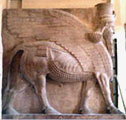
The figure represented the might of Assyria in that it is endowed with intelligence, strength of a bull (or a lion) and the ability of an eagle in flight. They were always in pairs, erected as gateway guardians, they adorned the palaces of the more important Assyrian kings from Assurnasirpal II (883-859 BC), until Esarhaddon (680-669 BC), their absence from the palace of king Assurbanipal (668-627 BC) was perhaps due to the lack of availability of large enough stone blocks. At that time some of Esarhaddon’s bull-colossus were made from separate stone blocks fitted together to form one statue.
The following are inscriptions from Esarhaddon's palace: -
{May the guardian bull, the guardian genius, who protects the strength of my throne, always preserve my name in joy and honour until his feet move themselves from their place...}
Another inscription of the king Esarhaddon: -
“Bull and lions carved in stone, which with their majestic mien deter wicked enemies from approaching. The guardians of the footsteps, the saviours of the path of the king who constructed them, right and left I placed them at the gates.”

Sargon II (721-705 BC) had to cross the Tigris and take a risky river journey, to get large blocks, which it is known that he had lost at least one colossus to the river.
The drawings on the palace walls of Sennacherib (704-681 BC) show that some colossus has been carved on the spot were the stones had been found and then carried to the palace.
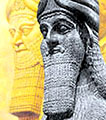
Crowned Head: - The crowned human head represent intelligence and each statue have the face of an Assyrian king, depending in what king’s time the statue was erected. And in what palace the bull statue was found, Most of the bull statues found in the palace of Sargon II, had the face of Sargon II.

The horned caps:- The creature wears the horned cap decorated with two horns or some times three as the symbol of divinity; in Neo-Assyrian times the horns represented the national God Assur. Some times three horns represented Assur, Anu (An) and Enlil (the three Mesopotamian Deities).
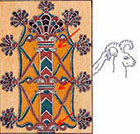
The Assyrian artists had added the horns to the secret tree of life as a good luck charm against the evil eye (the Flora of the Assyrian Monuments by E. Bonavia).

The Crown:- Some times the king’s cap “crown” was decorated in feathers and rosettes, the feathers are of an Eagle, but the meaning of the rosette is unclear some say it is a symbol of the sun, some say of stars. Single rosette is often seen as a decoration on wrist-straps worn by both human and supernatural figures in Neo-Assyrian monuments.
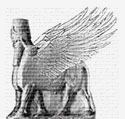
Wings: - The most powerful creature in the sky “the Eagle” the ancient Assyrians have gave their statues, wings of the Eagle, as a symbol of sovereign power, and they represent the lordship over the might.
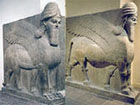 Body: - The body of a bull, and some times the ears too. (Or body of a lion with claws, as you can see in the picture above). Why the bull you may ask?
Body: - The body of a bull, and some times the ears too. (Or body of a lion with claws, as you can see in the picture above). Why the bull you may ask?
It could been driven from the wild bulls, it remained as a separate species throughout the north-western Mesopotamia as late as Neo-Assyrian times, when they were hunted by Assyrian kings. The wild bull must have been a truly awe-inspiring beast, six feet tall at the shoulders and with an enormous pair of wide-sweeping horns. Domestic cattle were tiny by comparison, as a visual and literary image of power and strength, wild bulls preoccupied the Mesopotamian imagination, a metaphor for deity or a suitable comparison for heroes or kings.
In the early painted pottery the bull has been thought to symbolize a storm Deity (Gods and Demons of Ancient Mesopotamia by J. Black and A. Green).
Also the creatures were decorated with belts signifying their superhuman powers.

Legs: - Most of the Assyrian winged bulls have five legs some four.
Viewed from the front, the creature stands firmly in place; from the side he appears to stride forward. Some statue’s heads appears to be steering on one side, some holding in there hands lion cubs or gazelles, as seen in the picture below.
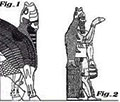 Fig_1) A very unique Assyrian winged bull; elegantly dressed in fish skin from the top of his cap all the way down to the back. Note, even the ears have been replaced with fins.
Fig_1) A very unique Assyrian winged bull; elegantly dressed in fish skin from the top of his cap all the way down to the back. Note, even the ears have been replaced with fins.
Fig_2) A human-looking figure dressed in the skin of a fish and holding a bucket and a cone. Drawing from a monument stone relief, one of a pair flanking a doorway of the temple of the deity Ninurta at the Assyrian city of Kalhu (modern Nimrud), where they been erected during the reign of king Ashurnasirpal II.
Fish in ancient Mesopotamia symbolized wisdom and it was associated with the god of wisdom and water (Enki).
Persian empire’s adaptation of the Assyrian winged bulls
Persia suddenly expanded in the 6th century BC. When Cyrus II of Parsa, defeated the Medes (an Aryans kingdom to the south, who had captured Babylon in 539 BC), and he conquered Assyria, Asia Minor, Babylonia and went as far as India, and in 546 BC, he united his conquests into one single empire.

When the king of Persia, decided to build for himself a capital city, or what they became known as “royal camps” Persepolis was one of them. In building palaces at Persepolis, the Persians employed artists and builders from all over the Mesopotamia region. Many of them came from Assyria, and with them they brought their style of Art, Architecture, and heritage, which they combined and used to build the palaces at Persepolis, the winged bulls are some of the things that bare the marks of the Assyrio-Babylonian architecture and influence.

They not only passed their artistic knowledge to the Persians but its also known that Cyrus king of Persia adopted the New Year Festival of the Assyrians and made it an occasion for celebration and receiving tribute and homage from his people.
On one of his winged bulls, Sargon II has wrote in cuneiform “who ever would destroy the creation of my hands, let Assur, the great lord, destroy his name and his posterity on earth”.

















